The Zenbook S13 OLED 2023 stands out as the world’s thinnest and lightest laptop, boasting remarkable dimensions of just 10.9mm in thickness and a mere 1kg in weight. These numbers speak the truth, leaving no room for doubt. This Asus Zenbook S13 OLED review comes after we’ve spent almost a week with it, so we can say with confidence that it offers an incredibly comfortable experience. Its portability knows no bounds, allowing us to effortlessly carry and utilize it anywhere, anytime. This thin, lightweight, and resilient laptop truly excels in this aspect.

While Asus’ promotional claims about this laptop may initially overwhelm users, it is crucial to maintain composure and thoroughly examine the details, particularly when considering the price tag of $1,400. Such a significant investment demands a closer inspection, prompting us to delve into this Asus Zenbook S13 OLED review and ascertain its value for money.
Asus Zenbook S13 OLED Review
Design
It is an undeniable fact that laptops weighing 1kg or less are typically crafted from lightweight yet sturdy materials. Examples of such laptops include the LG Gram, Zenbook S13 OLED, ExperBook B9, and the MacBook Air M2, albeit the latter weighing 1.2kg. Additionally, thin and lightweight laptops like the LG Gram or ExpertBook B9 often adhere to the rigorous standards of the US military’s durability criteria, contributing to their higher price points.
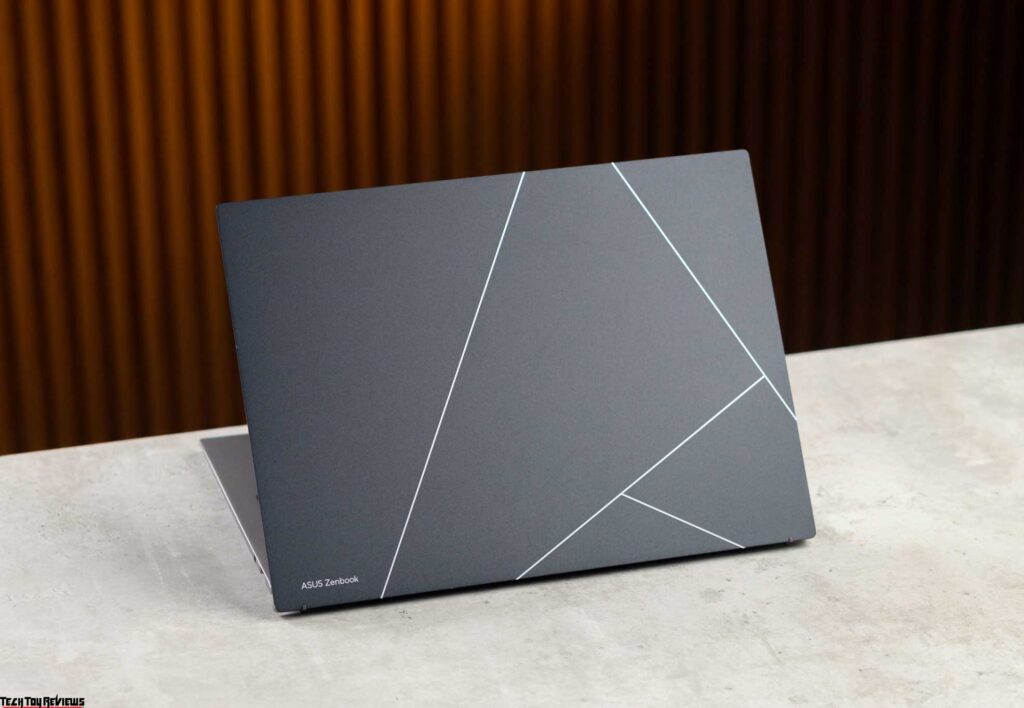
The Zenbook S13 OLED 2023 follows suit by meeting the MIL-STD 810H standard for durability, providing users with peace of mind. Let us now examine the specific materials used in the construction of this laptop.
Asus employs a combination of aluminum and magnesium alloy to fashion the Zenbook S13 OLED, a key factor contributing to its impressive weight. Furthermore, the company carefully considers other components to further reduce the machine’s weight, such as OLED panels (making the Zenbook S13 OLED the lightest OLED laptop available today, although OLED remains a less popular option compared to LCD on laptops). It’s worth noting that the protective glass and screen border utilizes plastic-like materials, making them susceptible to scratches if mishandled or not properly maintained. However, Asus generously equips the Zenbook S13 OLED with a 63Wh battery, resulting in an exceptional battery life, which we will delve into in closer detail in the subsequent sections of this Asus Zenbook S13 OLED review.
Despite its thin and incredibly lightweight design, this laptop exhibits no signs of creaking or easy bending. We conducted rigorous tests, attempting to bend the laptop, but it remained resilient and showed no signs of bending or damage. Even when we stuffed it into a backpack alongside numerous other items, deliberately exerting pressure on the device, the laptop continued to function flawlessly. This serves as a testament to its robust build quality. Notably, the keyboard frame deserves special mention, as it exhibits minimal flex compared to the LG Gram.
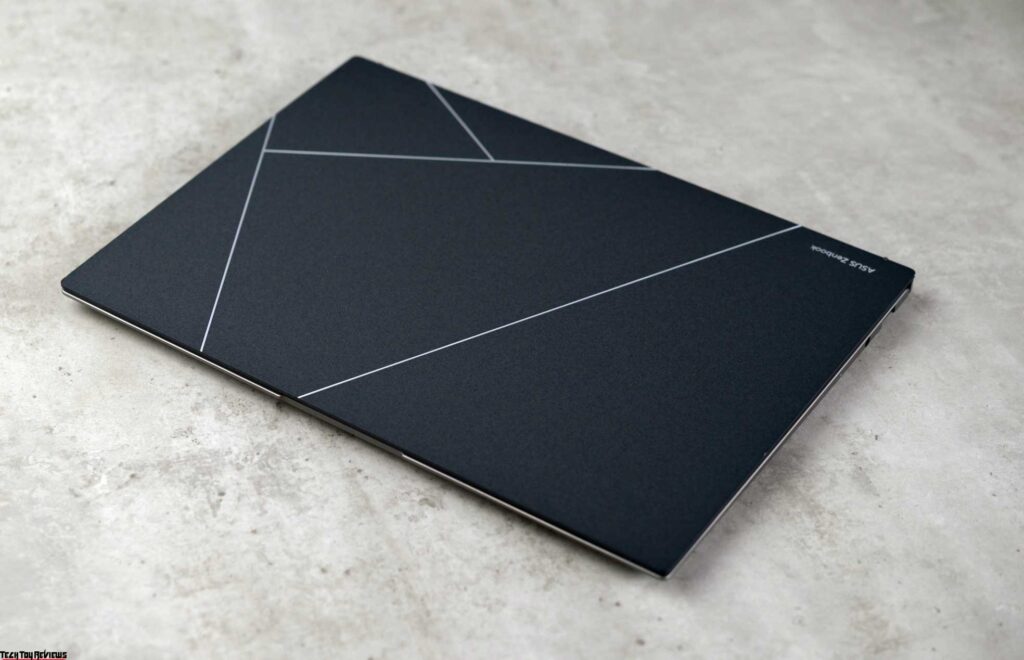
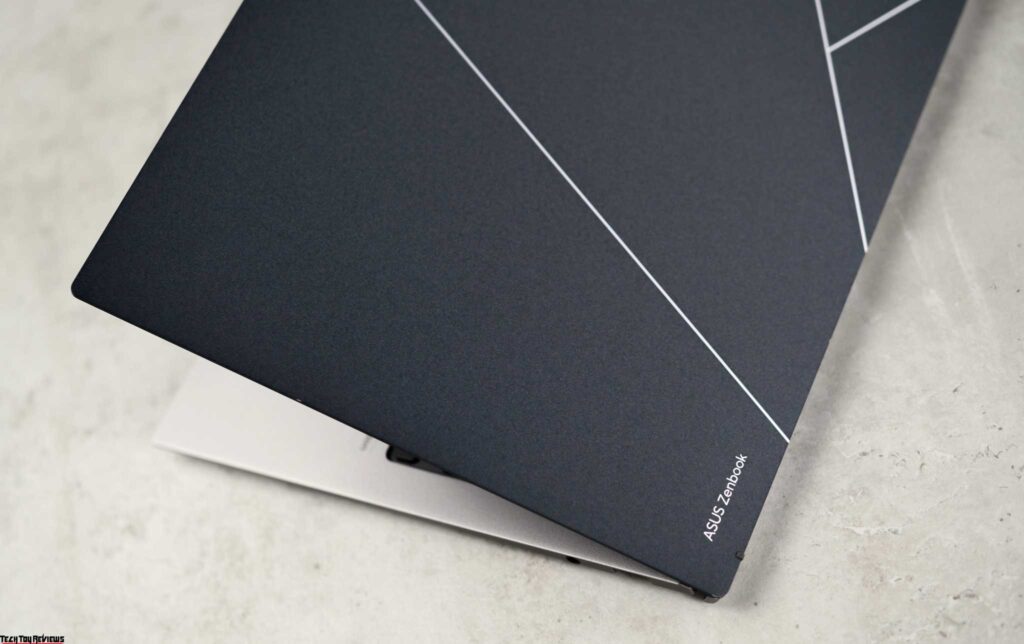
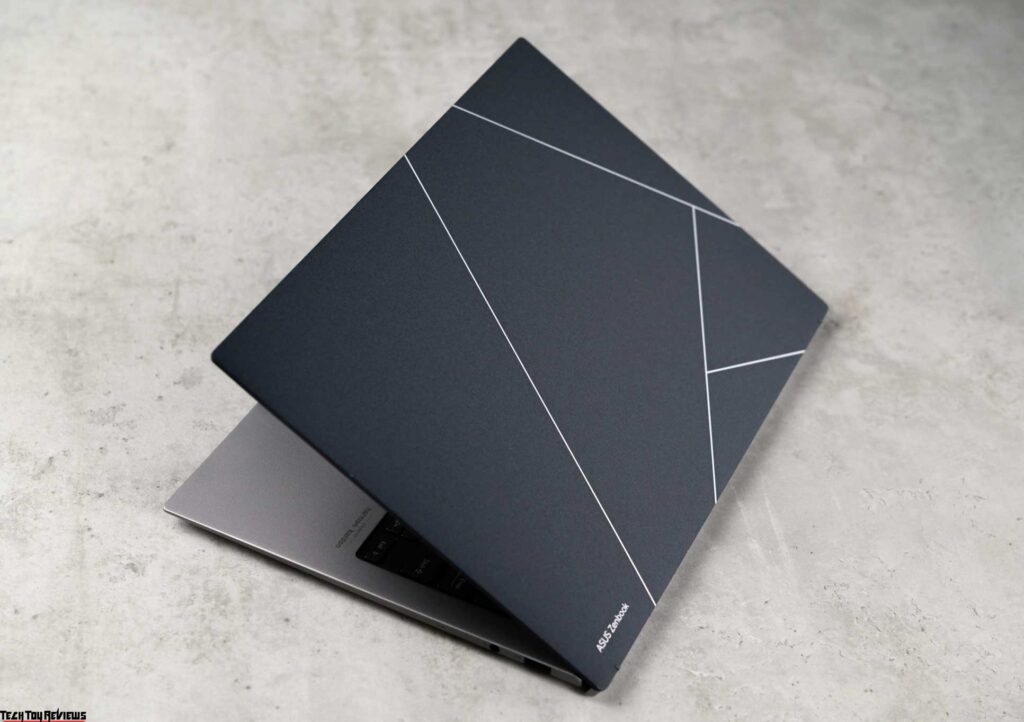
Upon closer inspection, you’ll notice that the keyboard frame is crafted as a single solid block, with the keycaps seamlessly integrated. This construction method significantly reduces flex, distinguishing it from the LG Gram models released in 2022 and earlier.
An added advantage of the Zenbook S13 OLED is its comprehensive range of ports, including a 3.5mm audio jack, two USB-C Thunderbolt 4 ports, USB-A ports, and an HDMI 2.0 port. These full connectivity options, particularly the presence of USB-A and HDMI, prove indispensable for office workers. Many peripheral devices, such as mice and keyboards, still rely on USB-A ports. Additionally, some businesses have their IT departments disable Bluetooth functionality on certain devices for employees, further emphasizing the ongoing need for USB-A connectivity.
We find the overall design of this year’s Zenbook S13 OLED to be highly appealing. It distinguishes itself from the previous generation with a fresh and captivating look that retains its inherent beauty. Side A showcases enlarged cut lines, which serve as the new logo of the Zenbook series. Asus has made suitable and harmonious color choices, resulting in an aesthetically pleasing appearance. Additionally, this laptop stands out by having fewer stickers, adding to its visual charm.



The 2023 iteration sets itself apart from its 2022 predecessor through various enhancements. The hinge, in particular, utilizes the ErgoLift mechanism in a notably advanced manner. The overall interface of the Zenbook S13 OLED 2023 exudes a certain stylishness, departing from the simplicity of the 2022 version. Furthermore, the ease of opening the device with a single hand has greatly improved compared to the Zenbook S from 2022, where it proved to be quite challenging. However, it is worth noting that this particular aspect presents both convenience and potential concern.
The hinge area also serves as the primary heat dissipation zone for the laptop. Consequently, the heat is directed toward the bottom edge of the screen. Thus far, we have not encountered any issues in this regard. However, we cannot definitively ascertain if prolonged usage will have any adverse effects on the screen.
One notable aspect of the Zenbook S13 OLED hinge is that upon opening it, there is a slight sense of uncertainty. This type of hinge is less common among the high-end laptops we have used, which is a minor drawback in terms of the device’s finishing, especially considering its price. Furthermore, when examining the sides, there appears to be a slight gap between the screen and the keyboard frame. We are unsure if this is specific to our Asus Zenbook S13 OLED review unit or if it is a common flaw in Asus laptops. Nonetheless, it is a detail that should not be present in a laptop with a premium price tag of up to $1,400.
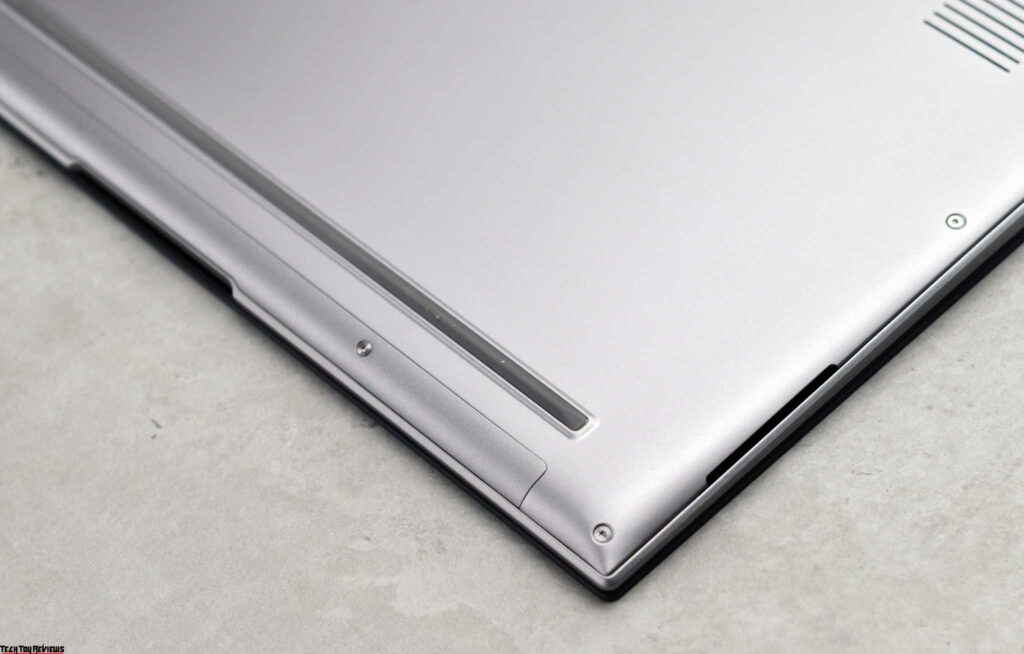
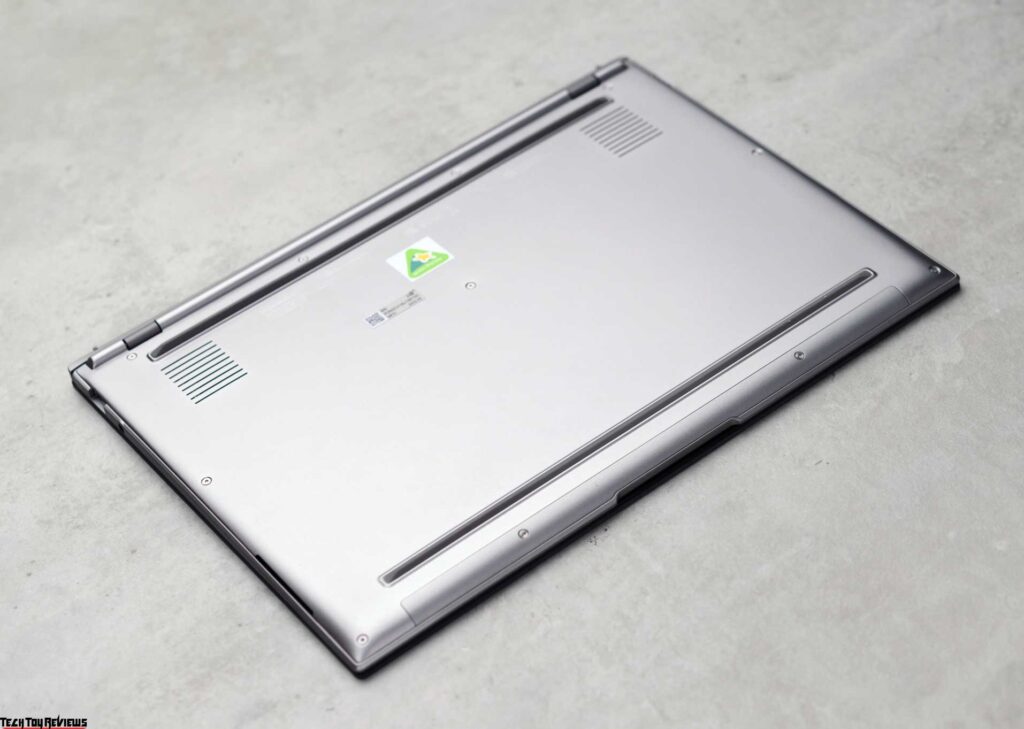
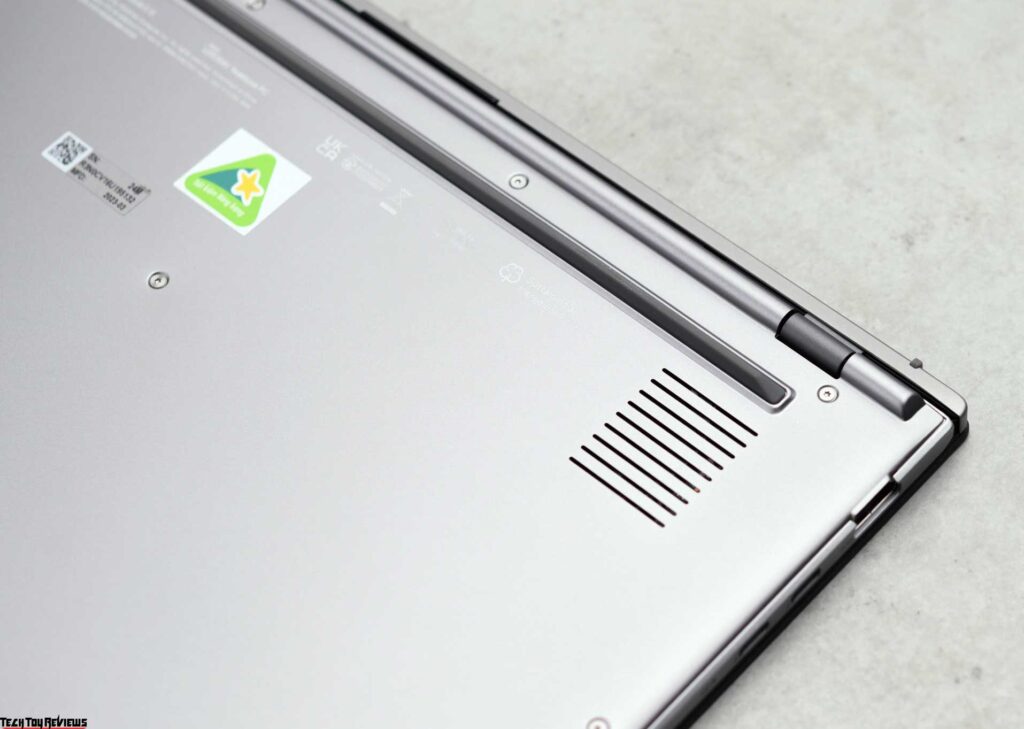
Speaking generally about the design of the Zenbook S13 OLED, we appreciate Asus’ changes to the hinge compared to the 2022 generation. The reintroduction of USB-A and HDMI ports is a valuable addition, particularly for office users. The laptop maintains a thin profile, surpassing the 2022 series, while still exuding a sense of sturdiness. It also boasts a more stylish appearance compared to its predecessors. Asus has successfully modernized the Zenbook S13 OLED series. However, this comes at the cost of placing the heatsink in a position that may cause concerns, along with the aforementioned finishing flaws. We appreciate both the design of the 2022 series and the 2023 series, but if we had to choose one, we would opt for the 2023 model. Not only does it feature an appealing design, but it also offers additional connection ports necessary for professional use.
Display
The Zenbook S13 OLED boasts a remarkable OLED panel referred to as the Lumina OLED by Asus. It is a stunning display that performs exceptionally well, offering an impressive array of parameters. With a 13.3-inch panel and a resolution of 2.8K (2880 x 1800), it delivers sharp visuals. The panel’s brightness reaches 550nits, and it is VESA DisplayHDR True Black 500 certified. It covers 100% of the DCI-P3 color space and achieves a remarkable 1000000:1 contrast ratio. Additionally, it supports 10-bit depth color and holds the PANTONE Validated certification. The glossy glass coating further enhances clarity, and the 16:10 aspect ratio provides a better display experience compared to the more common 16:9 aspect ratio found in 13.3″ screens.

The only drawback of the panel on this laptop is its refresh rate, which is limited to 60Hz. It would have been much smoother if it had a 90Hz refresh rate. However, in terms of display quality, there is nothing to complain about. The visuals are stunning, and the panel exhibits exceptional performance across various color spaces. The sRGB range, Adobe RGB, and DCI-P3 all boast highly impressive parameters:
- sRGB: 100%
- Adobe RGB: 90%
- DCI-P3: 98%
- Delta E: Approximately 2
- At 100% brightness: 372 nits, contrast: 8750:1, white point: 6700

Located at the top edge of the screen, there is a webcam with a resolution of 1080p. It also features an additional infrared sensor, enabling face unlock functionality.
Keyboard & touchpad
The keyboard of the Zenbook S13 OLED leaves much to be desired. The key travel feels somewhat shallow, but the layout is reasonably organized. Unlike the older Zenbook models, the Fn key cluster, including Home, End, PgUp, and PgDn, no longer occupies an entire column.
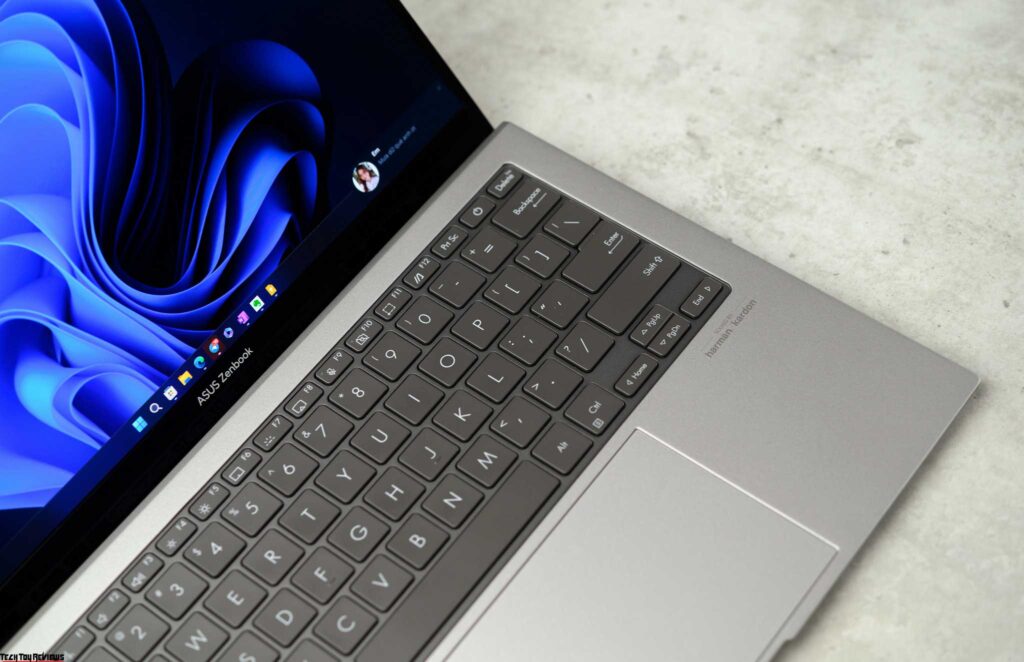



The touchpad on this device no longer features a Numpad number pad, but it compensates with a larger size compared to the 2022 generation, which we particularly appreciate. Given the choice between a Numpad or a larger touchpad area, we would opt for a larger touchpad. After all, a bigger touchpad provides a more comfortable experience, especially when using Windows computers. However, it would have been even better if the touchpad had force-sensitive capabilities. We wish Asus would enhance the touchpad in this regard. Considering Asus’ reputation as a creative company that prioritizes user experience, integrating a force-sensitive touchpad, even alongside the Numpad, shouldn’t be too challenging for them, especially since they have already implemented this feature in some of their models.
Asus Zenbook S13 OLED 2023 specifications
- Operating System: Windows 11 Pro (64-bit)
- Processor: Intel Core i7-1355U (13th Gen), 1.7 to 5 GHz Dual-Core, 1.2 to 3.7 GHz Efficiency 8-Core, 12 MB L3 Cache
- Graphics: Intel Iris Xe (Integrated)
- Memory: 32GB LPDDR5 (Onboard)
- Storage: 1 x M.2 PCIe 4.0 x4 SSD (In Use)
- Display: 13.3-inch OLED panel, 2.8K Non-touch Screen
- Aspect Ratio: 16:10
- Resolution: 2880 x 1800
- Brightness: 550 nits/cd/m2 (Peak)
- Color Gamut: 100% DCI-P3
- Refresh Rate: 60 Hz
- Contrast Ratio: 1,000,000:1
- Response Time: 0.2 ms
- Ports: 1 x USB-A 3.1/3.2 Gen 2, 2 x Thunderbolt 4 (Supports DisplayPort and Power Delivery), 1 x HDMI 2.1, 1 x 1/8″ / 3.5 mm Headphone/Microphone Input/Output
- Connectivity: Wi-Fi 6E (802.11ax); Tri-Band (2.4, 5, & 6 GHz) 2 x 2 MU-MIMO, Bluetooth 5.2
- Webcam: 1080p User-Facing Camera with built-in Microphones & Speakers
- Battery: 63 Wh 4-Cell Lithium-Ion, 65 W with USB-C power adapter
- Keyboard/TouchPad: Chiclet Notebook Keyboard with Backlight, Number Pad, Pointing Device TouchPad
- Security: Dedicated Hardware TPM Security Chip, Facial Recognition
- Dimensions: 11.66 x 8.52 x 0.46″ / 29.62 x 21.63 x 1.18 cm
- Weight: 2.2 lb / 1 kg
Performance
The Zenbook S13 OLED of this year offers only one version, which utilizes the Intel Raptor Lake-U platform instead of the AMD Ryzen 6000 series found in the 2022 generation. Specifically, this machine is equipped with the Intel Core i7-1355U, a 10-core, 12-thread processor. It comes with 32GB of LPDDR5 RAM and a 1TB PCIe 4.0 SSD, making it a robust and comprehensive configuration for office work, especially with an ample amount of RAM. It’s worth noting that our Asus Zenbook S13 OLED review unit represents the highest configuration option available for this device.
The Core i7-1355U is a CPU with a 15W TDP, but we were impressed by its P-core clock speed of 5.0GHz and E-core clock speed of 3.7GHz. It consists of 2 P-cores and 8 E-cores. However, when compared to Raptor Lake-P, the performance of Raptor Lake-U is theoretically not as strong.
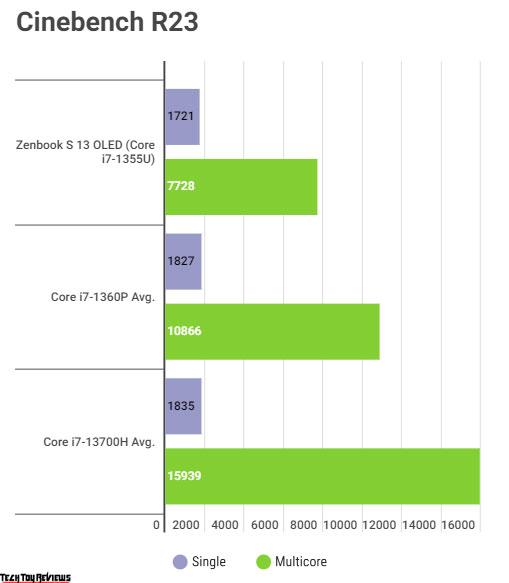
In practice, our findings align with the theoretical parameters. The Core i7-1355U in the Zenbook S13 OLED 2023 model can boost up to 41W (PL2 Dynamic) and stabilize at 20W. The maximum temperature reaches 97 degrees Celsius, which means the machine cannot sustain high levels of electrical power for extended periods, particularly when operating at the highest performance level. The boost clock of the Core i7-1355U on the Zenbook S13 OLED reaches 4.7GHz for single-core tasks and 3.2GHz for multi-core tasks. Switching to Balanced mode reduces the multi-core clock speed to 2.3GHz at 23W and the single-core clock speed to 3.7GHz at 20W.
Nevertheless, this laptop doesn’t aim to boast about its performance or achieve impressive benchmark scores. Instead, it focuses on delivering a satisfying work experience, and in that regard, the Zenbook S13 OLED excels. Thanks to its ample RAM and high-speed SSD provided by Samsung, tasks such as decompression and opening applications are executed swiftly.
Under heavy usage, the fan noise can become quite noticeable, reaching approximately 45-47 dB. Despite the laptop’s slim and lightweight design, Asus has equipped it with two cooling fans and two copper pipes. Compared to similar laptops, this cooling system is already impressive. It effectively prevents the machine from experiencing severe throttling when subjected to intensive workloads. Some other thin and light models may opt for a single fan, but ultimately their performance may suffer as a result.
In general, when it comes to work involving Office suite applications, the Zenbook S13 OLED proves to be more than capable of basic needs. Of course, there are various types of work with different requirements, but the Zenbook S13 performs well across the board. In our experience with ultrabook models, we find that having a higher amount of RAM is preferable, and even the minimum should be 16GB to ensure smooth operation without encountering any discomfort due to insufficient memory.
Battery life
Despite having a slightly lower capacity of 63Wh compared to its 2022 predecessor’s 67Wh, the Zenbook S13 OLED makes up for it by offering a thinner profile. However, the true highlight is the remarkable battery performance of this device. In practical terms, it proves to be highly reliable, lasting throughout the entire day, from 10 am to 8 pm on average.

The Zenbook S13 meets the stringent Intel Evo standards, and based on our experience with Intel Evo laptops thus far, it is uncommon to encounter poor battery life. Most laptops meeting these standards provide a minimum of 5 hours or more of usage. In the case of the Zenbook S13 2023 model, achieving 7-8 hours of continuous usage is quite normal. Our usage primarily revolves around office tasks, with the performance mode set to the Standard level in MyASUS, and the brightness adjusted to approximately 80-85%.
Final line
As we’ve mentioned before, having more RAM and a larger SSD capacity is desirable, but when the price tag reaches $1,400, we believe that this option will only appeal to a select few. In our opinion, the optimal choice would be to go for the 16GB RAM and 512GB SSD configuration, coupled with cloud storage solutions. With this option, the price becomes $500 more affordable, while still retaining the same design, build quality, screen, and battery as the $1,400 variant. Even at $900, the Zenbook S13 OLED 2023 delivers a remarkable experience.
Price and availability
The Asus Zenbook S 13 OLED 2023 (UX5304) can now be pre-ordered on Bhphotovideo.com and Newegg.com for $1,399.99.